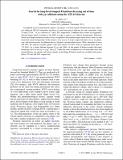Search for long-lived stopped R-hadrons decaying out of time with pp collisions using the ATLAS detector
Author(s)
Taylor, Frank E.
DownloadAad-2013-Search for long-live.pdf (2.311Mb)
PUBLISHER_POLICY
Publisher Policy
Article is made available in accordance with the publisher's policy and may be subject to US copyright law. Please refer to the publisher's site for terms of use.
Terms of use
Metadata
Show full item recordAbstract
An updated search is performed for gluino, top squark, or bottom squark R-hadrons that have come to rest within the ATLAS calorimeter, and decay at some later time to hadronic jets and a neutralino, using 5.0 and 22.9 fb[superscript −1] of pp collisions at 7 and 8 TeV, respectively. Candidate decay events are triggered in selected empty bunch crossings of the LHC in order to remove pp collision backgrounds. Selections based on jet shape and muon system activity are applied to discriminate signal events from cosmic ray and beam-halo muon backgrounds. In the absence of an excess of events, improved limits are set on gluino, stop, and sbottom masses for different decays, lifetimes, and neutralino masses. With a neutralino of mass 100 GeV, the analysis excludes gluinos with mass below 832 GeV (with an expected lower limit of 731 GeV), for a gluino lifetime between 10 μs and 1000 s in the generic R-hadron model with equal branching ratios for decays to q[bar over q][˜0 over χ] and g[˜0 over χ]. Under the same assumptions for the neutralino mass and squark lifetime, top squarks and bottom squarks in the Regge R-hadron model are excluded with masses below 379 and 344 GeV, respectively.
Date issued
2013-12Department
Massachusetts Institute of Technology. Department of PhysicsJournal
Physical Review D
Publisher
American Physical Society
Citation
Aad, G., T. Abajyan, B. Abbott, J. Abdallah, S. Abdel Khalek, O. Abdinov, R. Aben, et al. “Search for long-lived stopped R-hadrons decaying out of time with pp collisions using the ATLAS detector.” Phys. Rev. D 88, no. 11 (December 2013). © 2013 CERN, for the ATLAS Collaboration
Version: Final published version
ISSN
1550-7998
1089-4918